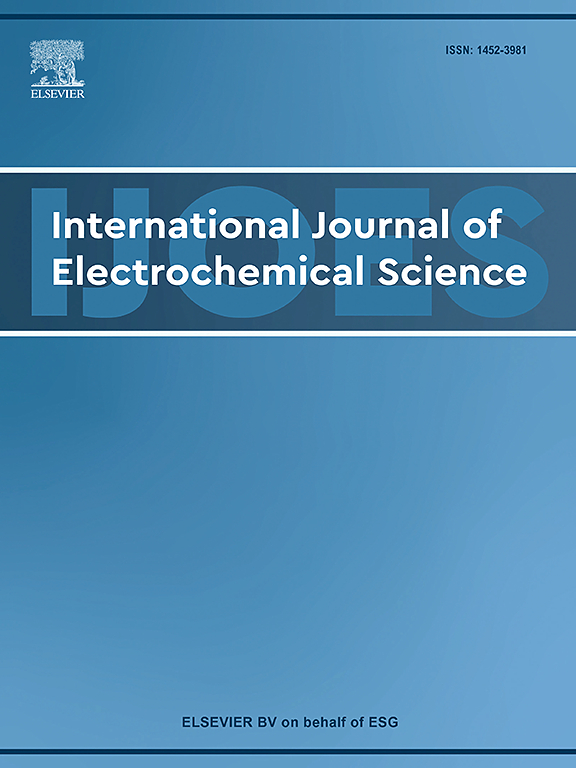微波辅助提取多糖的优化及其电化学指纹图谱特征研究
IF 2.4
4区 化学
Q4 ELECTROCHEMISTRY
International Journal of Electrochemical Science
Pub Date : 2025-09-12
DOI:10.1016/j.ijoes.2025.101180
引用次数: 0
摘要
本文研究了海地草多糖(HPS)的微波辅助提取(MAE)和电化学指纹图谱的优化。响应面法显示最佳的MAE条件为:68°C, 420 W, 22 min, 28 mL/g液固比,产率为6.38 %。HPS具有较强的抗氧化活性,在2 mg/mL时,DPPH的清除率为63.5 %。化学分析表明,糖醛酸含量为15.2 %,单糖结构多样,以葡萄糖(38.5 %)和半乳糖(24.7 %)为主。循环伏安法发现了一个准可逆的氧化还原对(Epa = +0.28 V, Epc = +0.12 V, Ag/AgCl在50 mV/s),而差分脉冲伏安法发现了三个不同的峰(+0.14 V, +0.31 V, +0.52 V)。+ 0.31 V峰与总糖含量呈强相关(r = 0.92),+ 0.52 V峰与糖醛酸含量呈中度相关(r = 0.68)。与传统方法相比,MAE表现出更高的效率,将提取时间从3 h缩短到22 min,比热水提取提高54.9% %。本研究建立了MAE提取HPS的有效方法,并引入了电化学指纹图谱作为快速表征多糖的工具,为质量控制和生物活性评价开辟了新的途径。本文章由计算机程序翻译,如有差异,请以英文原文为准。
Microwave-assisted extraction optimization of Hedysarum polybotys polysaccharide and study of their electrochemical fingerprint characteristics
This study investigated the optimization of microwave-assisted extraction (MAE) and electrochemical fingerprinting of Hedysarum polybotys polysaccharides (HPS). Response surface methodology revealed optimal MAE conditions: 68°C, 420 W, 22 min, and 28 mL/g liquid-to-solid ratio, achieving a 6.38 % yield. HPS exhibited strong antioxidant activities, with 63.5 % DPPH scavenging at 2 mg/mL. Chemical analysis showed 15.2 % uronic acid content and a diverse monosaccharide profile dominated by glucose (38.5 %) and galactose (24.7 %). Cyclic voltammetry revealed a quasi-reversible redox couple (Epa = +0.28 V, Epc = +0.12 V vs. Ag/AgCl at 50 mV/s), while differential pulse voltammetry identified three distinct peaks (+0.14 V, +0.31 V, +0.52 V). The + 0.31 V peak strongly correlated with total sugar content (r = 0.92), and the + 0.52 V peak moderately correlated with uronic acid content (r = 0.68). Compared to conventional methods, MAE demonstrated superior efficiency, reducing extraction time from 3 h to 22 min and improving yield by 54.9 % over hot water extraction. This study establishes MAE as an effective technique for HPS extraction and introduces electrochemical fingerprinting as a promising tool for rapid polysaccharide characterization, opening new avenues for quality control and bioactivity assessment.
求助全文
通过发布文献求助,成功后即可免费获取论文全文。
去求助
来源期刊
CiteScore
3.00
自引率
20.00%
发文量
714
审稿时长
2.6 months
期刊介绍:
International Journal of Electrochemical Science is a peer-reviewed, open access journal that publishes original research articles, short communications as well as review articles in all areas of electrochemistry: Scope - Theoretical and Computational Electrochemistry - Processes on Electrodes - Electroanalytical Chemistry and Sensor Science - Corrosion - Electrochemical Energy Conversion and Storage - Electrochemical Engineering - Coatings - Electrochemical Synthesis - Bioelectrochemistry - Molecular Electrochemistry

 求助内容:
求助内容: 应助结果提醒方式:
应助结果提醒方式:


